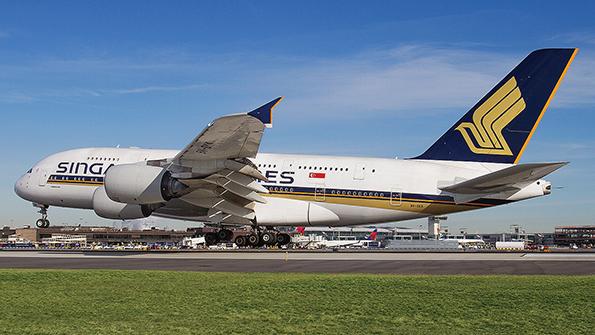
Airbus A380s have become a rare sight in Asia-Pacific skies over the past few years, but the recent surge in international demand has seen more airlines bringing A380s out of storage.
Carriers grounded most of their widebody fleets when the COVID-19 crisis hit in early 2020. Being the largest aircraft in operation and therefore the hardest to fill, virtually all A380s in the Asia-Pacific region were put into long-term storage.
- Nearly 35% of the region’s A380s have reentered service
- Some of the parked A380s will not return
A380s have been among the slowest of the widebody models to return, but now many of the region’s airlines are gradually reactivating these aircraft. The A380 fleet is rebuilding, although it will not fully return to its pre-pandemic size. Some Asia-Pacific airlines have decided to cut down or even phase out their A380 fleets as a result of restructuring and strategic reviews undertaken during the COVID-19 crisis.
There were 65 A380s in service with Asia-Pacific carriers in January 2020, according to the CAPA – Centre for Aviation fleet database (see chart). Two months later, the in-service total dropped to just four, as most were grounded.
The Asia-Pacific in-service A380 fleet stayed between five and seven aircraft through last October, but it has been steadily growing since then. There were 12 operational in January, and this number has now reached a two-year high of 22, representing an in-service rate of 34.9%. The A380 in-service total will continue to climb through the remainder of the year.
Airlines are reactivating more widebodies due to a rebound in international travel, which picked up in the second quarter. Pent-up demand and smaller fleets are combining to cause a supply shortfall.
Although the proportion of operational A380s is increasing, it is still far lower than that of other widebody models. There are 1,364 passenger widebody aircraft in service now in the Asia-Pacific region versus 322 inactive, an in-service rate of 80.9%.
Singapore Airlines (SIA) is the region’s largest operator of A380s, with 10 in service. Two more will be reactivated after retrofits are completed. The carrier had 19 before the pandemic began, although it announced in November 2020 that seven of these would not return to its fleet.
Qantas sent all 12 of its A380s into storage in the U.S. in 2020. Two of them are being retired early and will not reenter the Qantas network.
The Australian airline has reactivated three of the remaining 10, which are used on Sydney-Singapore-London and Sydney-Los Angeles routes. Two more A380s are expected to return to service by the end of August and will be used on Sydney-Los Angeles flights, the carrier tells Aviation Week. A sixth is planned to be activated by the end of December.
Qantas has accelerated the timeline for the return of its A380s. When it first parked these aircraft, the carrier estimated they would remain grounded for at least three years.
Korean Air has 10 A380s in its fleet. It is operating two of these, with the second having returned to service in July. The aircraft are being used for daily flights on the Seoul-New York route and three weekly flights to Hong Kong. The carrier plans to activate a third A380 in September, which will be deployed on daily flights to Tokyo.
The longer-term future of Korean Air’s A380s is less certain. Last year, the airline raised the prospect of retiring its A380s within five years, although Korean has since stressed that plans for these aircraft have yet to be confirmed.
All Nippon Airways (ANA) resumed flying two of its A380s in July. The carrier ordered three of the model in 2016, to use exclusively on its routes from Tokyo to Hawaii. The first two began commercial operations in 2019. ANA has a third A380 that has been delivered but has not yet entered service. In the meantime, this aircraft has been used for some customer events on the ground, such as a restaurant experience.
China Southern Airlines is operating all three of its A380s. The carrier previously had five, but it cut two from its fleet in the first half of this year. Asiana Airlines is operating two of its six A380s.
Two other Asia-Pacific airlines have A380s in their fleet but have kept them all grounded. These comprise six aircraft each for Thai Airways and Malaysia Airlines.
Malaysia Airlines has said its A380s will be sold and will not return to service with the carrier. The airline is in serious discussions with some parties regarding the disposal of the aircraft, CEO Izham Ismail said recently. Malaysia Airlines expects these aircraft to have left the group by year-end.
Thai Airways has listed two of its six A380s for sale. However, the fate of the other four remains in question, as the carrier has not confirmed whether they will be reactivated or retired.





